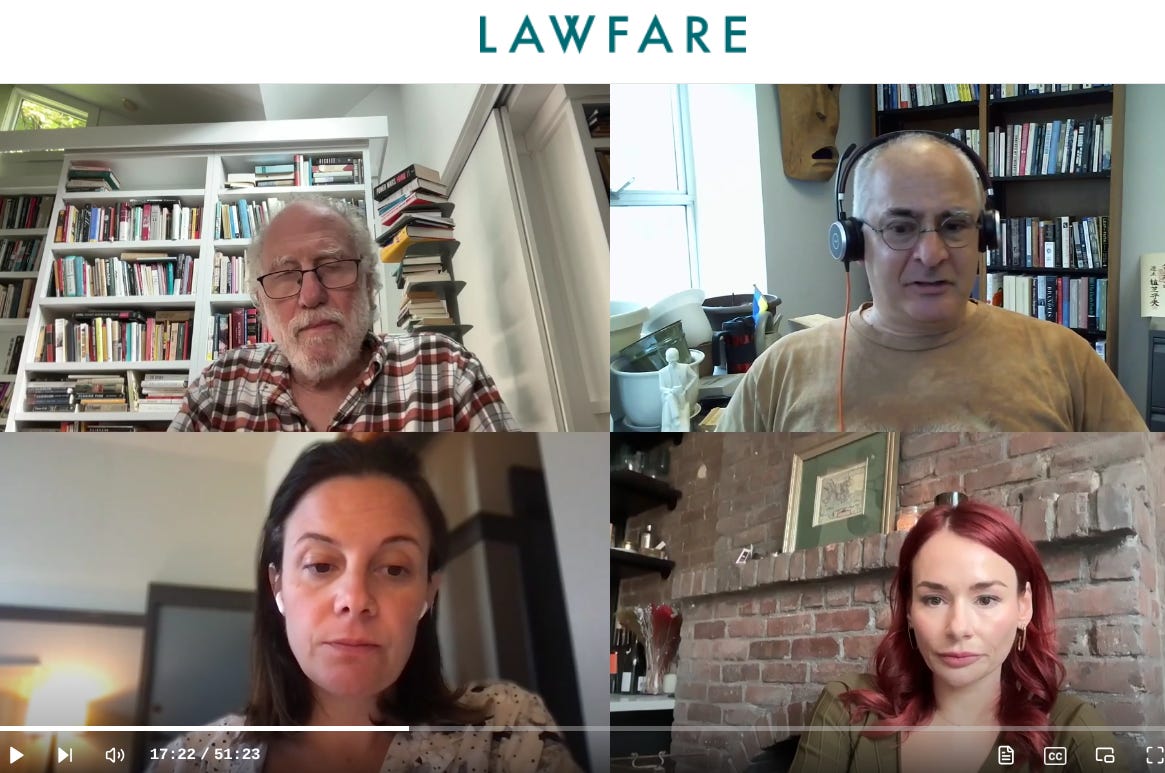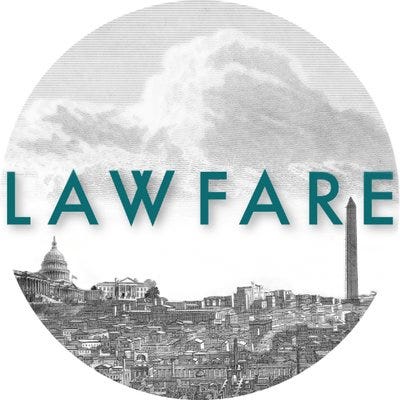Lawfare Has a New Series of Substack Lives
You should subscribe
Good Morning:
For those of you who don’t already subscribe to the Lawfare Substack, it’s time to fix that. The reason? We’ve just launched a new series of Lawfare Lives on it. You can watch them on YouTube also, but since I know you’re all Substack users, by nature of your reading this, I will flag for you this handy-dandy way to be sure you’re notified:
Here is our first livestream, which featured the very estimable Kate Klonick hosting and Bob Bauer and Anna Bower and me as guests:
Yesterday on #DogShirtTV, the estimable Holly Berkley Fletcher, the estimable Mike Feinberg, and I celebrated the exploits of a certain Sprite of Mischief by indulging our own various sillinesses. Halloween traditions, confessions of sin, and hypothetical Lawfare sporting events were discussed:
Your Music of the Day: Operation Brahms
Operations Brahms continues with a short song cycle of six songs, Opus 3. This group of songs is rarely recorded as a group, though the first of them is quite famous and is often recorded on its own. Here are a few performances of “‘Liebestreu,” which is not a terrible way to introduce yourself to the genre of Brahms songs (called “lieder” by pretentious people who like to use German words to describe musical terms with perfectly good English words).
And here is a playlist in which you can hear all six of the songs:
The songs are for voice and piano and are as follows:
Liebestreu (”Love’s Devotion”)
Liebe und Frühling (”Love and Spring”) (1)
Liebe und Frühling (”Love and Spring”) (2)
Lied (”Song”)
In der Fremde (”Away from Home”)
Lied (”Song”)
They are settings of poems by Gottfried Keller. They are very pretty and all have that dark brooding quality that comes to typify Brahms nearly all Brahms vocal music. They also have the distinction, in my view, of being Brahms’s first work that is in sense about piano virtuosity. The nature of a song always features the singer, and there is no sign here of a young pianist itching to display his abilities.
All that said, if Brahms had only written these six songs, we wouldn’t remember him as one of the great 19th Century composers of lieder. He will do much better in the coming years, particularly as he begins to write more ambitious works for voice and as he acquires his ability to write some of the most gorgeous melodies anybody has ever written. That skill is only very nascent here.
Yesterday On Lawfare
Compiled by the estimable Isabel Arroyo
Reductions in Force During Shutdowns
Nick Bednar evaluates the Trump administration’s plan to use the looming government shutdown to reduce the federal workforce permanently. Bednar breaks down how reductions in force (RIFs) linked to a temporary lapse in appropriations would break with traditional RIFs and discusses how Congress could protect federal employees.
By law, the criteria for determining which employees are excepted from furlough during a shutdown bear no relationship to the criteria for selecting employees for separation in a RIF. The Trump administration has increasingly sought to blur this distinction. Issued in February, Executive Order 14210 instructed agencies to “initiate large-scale reductions in force,” prioritizing employees “who are not typically designated as essential during a lapse in appropriations as provided in the Agency Contingency Plans.” As Bridget Dooling explains, “the categories used for RIF planning and those used for shutdown planning are apples and oranges.”
OMB’s recent memo goes further than shutdown furloughs, directing agencies to use the shutdown as an opportunity to issue RIF notices to “all employees” funded by discretionary funding that implement programs, projects, or activities deemed inconsistent with Trump’s priorities. This approach marks a sharp departure from the historical practice that has governed agency management during lapses in appropriations.
Clearer Laws Make for Safer Grids
In the latest installment of Lawfare’s Foreign Policy Essay series, Jesse Humpal explains how clarifying state laws could make U.S. energy grids more secure, highlighting the value of mandatory signage, clear penalties for energy facility trespassing, and joint training between police and utility operators.
Since 2018, 18 states have adopted critical infrastructure protection statutes. These laws do not require that every fence be fortified and that police guard every gate. Instead, they define which facilities are covered, specify prohibited conduct (such as trespassing, vandalism, or tampering), and set consistent penalties. Data that I have collected on this legislation and the targeting of energy facilities shows that the adoption of such laws correlates with a 27 percent decline in interference.
When Governments Pull the Plug
Theodore Christakis discusses European Union (EU) policymakers’ concerns about U.S. companies shutting off digital services in Europe. Christakis describes how—ironically—EU regulations functionally flipped a kill switch on Microsoft services to the Indian energy company Nayara, then called for new international legal architecture to avert disruptive kill-switch situations in the future.
These cases demonstrate that the narrative among European policymakers needs to move beyond a binary U.S.-EU frame to a genuinely polycentric one. Europe is right to worry about dependencies that can become vulnerabilities; the case for strategic autonomy is real. But focusing only on a hypothetical American “plug-pull” is incomplete. The EU, the U.K., the U.S., India, and other jurisdictions all wield legal instruments—including sanctions, export controls, and trust-infrastructure rules—that can precipitate service interruptions. Many hands can pull a plug. While it is clear that historically a kill switch has been used very rarely and in a narrow and targeted manner, theoretically, and depending on the circumstances, the switch might be accessible to more than one major power, creating a complex and unpredictable global digital environment for operators and users alike.
Podcasts
On Lawfare Daily, I sit down with Scott R. Anderson, Anna Bower, Eric Columbus, and Roger Parloff to discuss the Supreme Court’s grant of certiorari in FTC Commissioner Rebecca Slaughter’s challenge to the president’s attempt to fire her, the indictment of former FBI Director James Comey, the Supreme Court allowing President Trump to withhold foreign aid funds, a lawsuit challenging warrantless immigration arrests in D.C., and more.
Videos
On Lawfare Live, Kate Klonick sits down with me, Bower, and Bob Bauer to discuss the Trump administration’s politicization of the Justice Department, Comey’s indictment, and the future of politicized criminal prosecutions. As mentioned above, if you subscribe to Lawfare’s Substack, you will get notified of these events on the platform in real time:
Sprite of Mischief Update
I reported on a Sprite of Mischief action hear the house of one Stephen Miller:
I am informed that the signs in question have been removed.
How very Russian embassy!
They will, I am also informed, be replaced—in larger numbers.
Stay tuned.
Today’s #BeastOfTheDay, nominated by the estimable Ruth Marcus, is this moose and her calf, whom—Ruth informs me—she came home to find right on the other side of her window. This is what happens if you live in Wyoming.





In honor of today’s Beast, move to Wyoming.
Keep reading with a 7-day free trial
Subscribe to Dog Shirt Daily to keep reading this post and get 7 days of free access to the full post archives.








